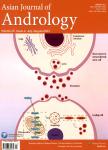Increased expression of PELP1 in human sperm is correlated with decreased semen quality
Increased expression of PELP1 in human sperm is correlated with decreased semen quality作者机构:Department of Cell Biology Faculty of Health Sciences Poznan University of Medical Sciences Rokietnicka 5D Poznan 60-806 Poland Division of Infertility and Reproductive Endocrinology Faculty of Medicine I Poznan University of Medical Sciences Polna 33 Poznan 60-535 Poland.
出 版 物:《Asian Journal of Andrology》 (亚洲男性学杂志(英文版))
年 卷 期:2018年第20卷第5期
页 面:425-431页
核心收录:
学科分类:0710[理学-生物学] 07[理学] 0905[农学-畜牧学] 08[工学] 09[农学] 071007[理学-遗传学] 0901[农学-作物学] 0836[工学-生物工程] 090102[农学-作物遗传育种]
基 金:supported by the National Science Centre Poland grant
主 题:male infertility proline glutamic acid- and leucine-rich protein 1 semen parameters sperm quality spermatozoa
摘 要:Proline-, glutamic acid-, and leucine-rich protein 1 (PELP1) is a scaffolding protein involved in both genomic and nongenomic estrogen signal transduction pathways. To date, the role of PELP1 protein has yet to be characterized in human sperm and has not been associated with sperm parameters. To confirm the presence of PELP1 in human sperm, fresh semen samples were obtained from 178 donors. The study was designed to establish both mRNA and protein presence, and protein cellular localization. Additionally, the number of PELP1-positive spermatozoa was analyzed in men with normal and abnormal semen parameters. Sperm parameters were assessed according to the World Health Organization (WHO) 2010 standards. The presence of PELP1 in spermatozoa was investigated using four precise, independent techniques. The qualitative presence of transcripts and protein was assessed using reverse transcription-polymerase chain reaction (RT-PCR) and western blot protocols, respectively. The cellular localization of PELP1 was investigated by immunocytochemistry. Quantitative analysis of PELP1-positive cells was done by flow cytometry. PELP1 mRNA and protein was confirmed in spermatozoa. Immunocytochemical analysis identified the presence of PELP1 in the midpieces of human sperm irrespective of sperm parameters. Becton Dickinson fluorescence-activated cell sorting (FACSCalibur^Tm) analysis revealed a significantly lower number of PELP1-positive cells in males with normal semen parameters versus abnormal samples (42.78% ± 11.77% vs 61.05% ± 21.70%, respectively; P = 0.014). The assessment of PELP1 may be a time-saving method used to obtain information about sperm quality. The results of our study suggest that PEPL1 may be utilized as an indicator of sperm quality; thereby, PELP1 may be an additional biomarker useful in the evaluation of male infertility.



